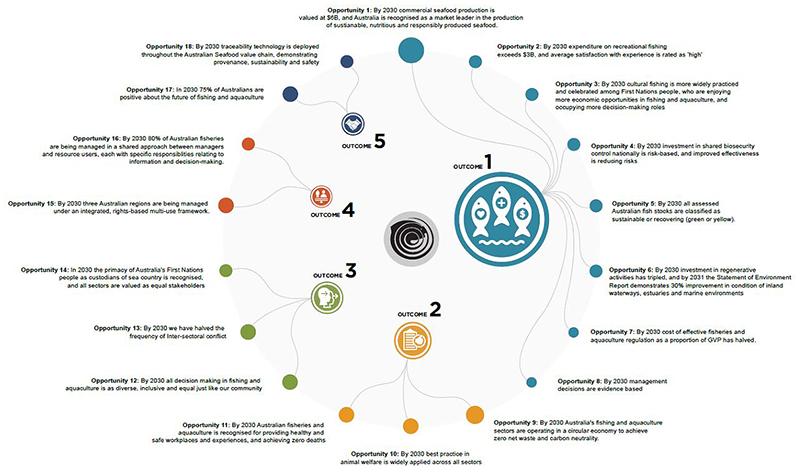Year 2 of 2020-2025 R&D Plan
Who we are
Fisheries Research and Development Corporation
FRDC invests in research, development and extension activities to increase economic, social and environmental benefits for Indigenous people, the aquaculture and commercial wild catch sectors, and recreational fishers, and which also delivers a public good benefit to the Australian community.
Purpose of this report
This report is intended to better connect stakeholders to our monitoring and the impacts of our research, and help us to better understand how we can shape our investments in response to what we are learning.
In this report, most of our focus is on our investments since the start of the financial year (July 2021 to February 2022). We are working to incorporate different time scales, e.g. over the life of the R&D Plan and beyond as we continuously improve our monitoring, evaluation and reporting.
2030 Vision
We invest in knowledge creation, dissemination and adoption, and build partnerships for the benefit of the Australian community so that Australia's marine and freshwater resources can be managed and used sustainably. FRDC delivers these functions in close consultation with a diverse stakeholder-base that includes Indigenous people, representatives of commercial and recreational fishing and aquaculture, as well as processors, consumers and the broader community.
Our strategic focus is articulated within our Research and Development (R&D) Plan, which is updated every five years. Our current 2020-25 R&D Plan presents a change in approach as we contribute to a shared strategic vision for fishing and aquaculture in 2030. A draft document titled "Fish Forever 2030" is the first attempt at a national articulation of a shared future for all sectors and stakeholders.
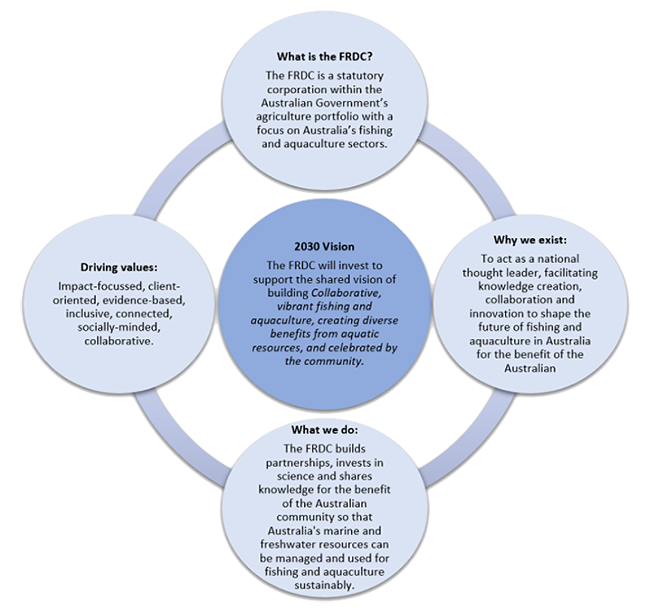
2020-25 R&D Plan
The R&D Plan will help deliver on the 18 opportunities outlined in Fish Forever 2030 through five key outcomes supported by five enabling strategies.
The plan focuses on cross-sectoral issues of national importance, to ensure jurisdictional and sector needs are met.
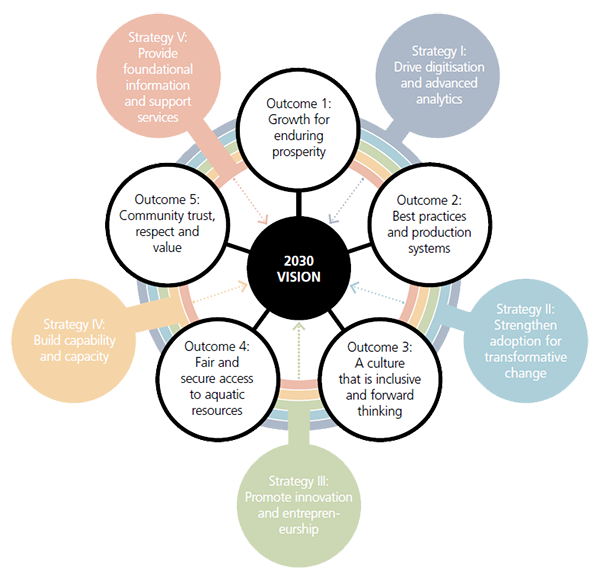
Monitoring and evaluation
Our monitoring and evaluation framework is our compass
Our Monitoring & Evaluation Framework provides a coordinated approach for monitoring, evaluation and reporting. The framework uses a results-based process for evaluating performance across the key functions we have undertaken during the life of our R&D Plan 2020-25.
FRDC monitors performance through a lens of seven multi-faceted elements, which builds on a core framework tracing inputs through to impacts.
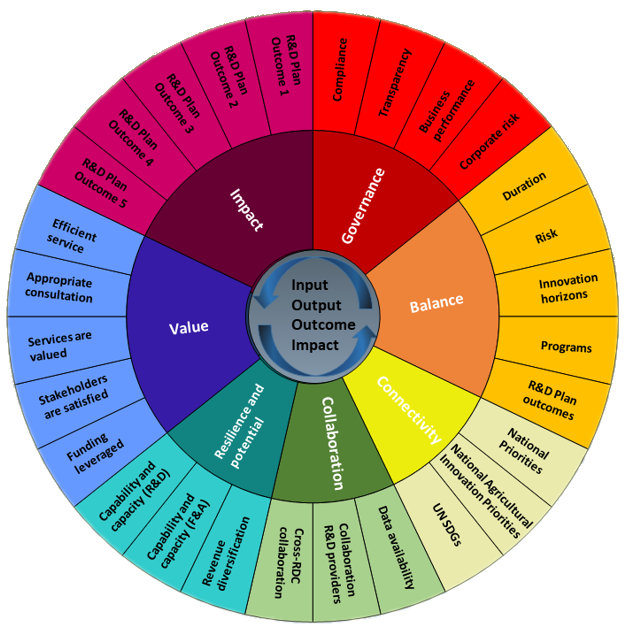
Governance
The framework is underpinned by strong governance to fulfill our statutory obligations and accountabilities to ensure the proper use and management of funds.
FRDC has consistently demonstrated good performance in governance. Further details can be found in the following reports:
- FRDC's monthly financial statements
- Australian National Audit Office (ANAO) report states FRDC's management of probity issues is effective', probity arrangements are appropriate', and the FRDC has 'complied' with applicable probity requirements.
- FRDC 2020-21 Annual Report
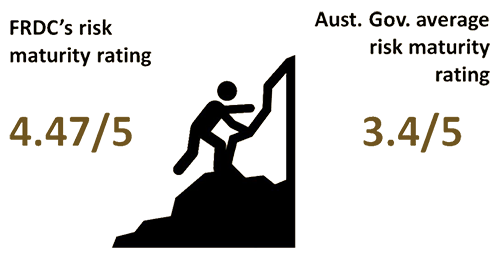
From Check-up PLUS performance report
Balance
FRDC Achievements are measured against planned Key Activities outlined in our Annual Operational Plan 2021-22 (AOP). The following tables demonstrate progress against the current AOP for each of the R&D Plan Outcomes.
| Problems/opportunities | Enabling strategies | Status |
|---|---|---|
| Tools to resolve provenance of fisheries and aquaculture products |
On track |
|
| Innovations to improve food safety |
On track |
|
| Increasing use of emerging technologies in fisheries and aquaculture; |
I: Digitisation and advanced analytics |
On track |
| Develop and progress implementation of strategy to increase adoption of FRDC-funded R&D |
II: Strengthen adoption |
On track |
| Identify opportunities to optimise fishing and production practices and operations, including utlisation of automation and alternative energy |
On track |
|
| Knowledge to improve understanding and societal values and expectations, and align activities across fishing and acquaculture |
On track |
|
| Solutions that pair Al and existing datasets to create decision support tools for business continuity and growth | I: Digitisation and advanced analytics |
On track |
| Determine critical financial, social and economical data elements and infrastructure to meet future needs | I: Digitisation and advanced analytics |
On track |
| Market and consumer research to understand success factors around use of brands |
On track |
|
| Options for optimising farming operations and increase growth and survival including knowledge to improve health and nutrition outcomes in aquaculture |
On track |
|
| Enhancing aquaculture broodstock - sourcing, quality and supply |
Started procurement |
|
| Selective breeding to enhance and improve production in farming systems |
On track |
|
| Identifying circular economy opportunities in fishing and aquaculture including options to design waste out of the system, keep products and materials in use and promote repair of natural systems |
On track |
|
| Explore opportunities to enable indigenous-led ventures |
On track |
|
| Opportunities for improving capability and capacity of the F&A workforce, including direct connection to training, career paths and job progression opportunities | IV: Build capability and capacity |
On track |
| Solutions for industry level biosecurity preparedness and border protection |
On track |
|
| Knowledge regarding sources of variability in target species |
On track |
|
| Knowledge regarding sources of variability in target species |
On track |
| Problems/opportunities | Enabling strategies | Status |
|---|---|---|
| Knowledge regarding feasibility of behavioural approaches for the uptake of best practice in fisheries and aquaculture operations |
II: Strengthen adoption |
On track |
| knowledge to improve understanding and societal values and expectations, and align activities across fishing and aquaculture | Procured | |
| Explore vehicles to deliver improved cross-sector collaboration, effectiveness and impact on shared strategic issues |
Started procurement |
|
| Improve intelligence to inform decision-making across fishing and aquaculture | V: Provide foundational information and support services |
More to come |
| Identification and extension of best safety practices |
II: Strengthen adoption |
On track |
| Develop and progress implementation of strategy to increase adoption of FRDC-funded R&D |
II: Strengthen adoption |
On track |
| Develop solutions to reduce waste, increase lifespan of products, and increase regenerative activities |
On track |
|
| Engage through cross-RDC Climate initiative to advance solutions to support resistance to a changing climate |
On track |
|
| Environmental sustainability and compliance initiatives |
On track |
|
| Exploring solution to reduce interactions with Threatened, Endangered and Protected species |
On track |
|
| R&D to define benefits of partial spatial protection |
Started procurement |
|
| Options for harvest and dispatching that deliver improved quality and welfare outcomes |
On track |
| Problems/opportunities | Enabling strategies | Status |
|---|---|---|
| Advance strategy to enhance innovation and entrepreneurship across fishing and aquaculture | III: Promote innovation and entrepreneurship |
On track |
| R&D to understand and report on cultural dynamics of fishing and aquaculture | V: Provide foundational information and support services |
More to come |
| Develop and progress implementation of strategy to increase adoption of FRDC-funded R&D | II: Strengthen adoption |
On track |
| Develop and commence implementation of a strategy to build capability, capacity and culture change across fishing and aquaculture |
IV: Build capability and capacity |
Started procurement |
| Development of a digital employment and training solution for Australia's seafood sector |
Started procurement |
|
| Improve the culture and raise the profile of safety amongst fishing and aquaculture participants to enable them to operate safely |
On track |
|
| Experiment with approaches to improve definition of priority problems/opportunities to deliver outcomes |
On track |
|
| Case studies that document benefits of diversity indecision-making |
More to come |
| Problems/opportunities | Enabling strategies | Status |
|---|---|---|
| Develop and progress implementation of strategy to increase adoption of FRDC-funded R&D |
II: Strengthen adoption |
On track |
| Explore case studies to enable enhancement of integrated management | On track | |
| R&D to understand and compare values of aquatic resource users | On track | |
| Reported statistics on level of adoption of harvest strategies and co-management across F&A | V: Provide foundational information and support services | More to come |
| Explore opportunities for meaningful two-way engagement with Indigenous communities on matters relating to access | On track | |
| Case studies demonstrating cross-sector collaboration on shared issues | On track | |
| Efforts to promote development and adoption of frameworks and management styles that allow flexibility across fishing and aquaculture |
II: Strengthen adoption |
On track |
| Global review of how fisheries and aquaculture have been accounted for in the Blue Economy and cross-sector ocean governance | More to come |
| Problems/opportunities | Enabling strategies | Status |
|---|---|---|
| Develop and progress implementation of strategy to increase adoption of FRDC-funded R&D | II: Strengthen adoption | On track |
| Case studies and extension activities to share insights from successful cross-sector collaboration on shared issues | V: Provide foundational information and support services | On track |
| Develop and incorporate cross-sector insights, metrics and analytics into tracking of community and sector values | II: Strengthen adoption | More to come |
Innovation Horizons
FRDC is tracking investment against innovation horizons to help understand the extent to which innovations and disruptive ideas are generated and achieved.
Horizon 1: Ideas support continuous innovation in a company's existing business model and core capabilities in the short-term. This is characterised by improving existing approaches and technologies within industry sectors.
Horizons 2 and 3: Ideas extend a company's existing business model and core capabilities to new customers, markets, or targets. These innovations might involve adapting technology, processes, or revenue stream structures that already function well in other industries to our own. Horizon 3 ventures are long-term innovation projects that are typically associated with non-incremental innovation (disruptive, radical, or architectural innovations).
| Horizon | $ | % |
|---|---|---|
| 2/3 | 304,985 | 0.94 |
| 1 | 32,101,235 | 99.06 |
| Total | 32,406,220 | 100 |
Connectivity
This element seeks to enable understanding and enhancement of linkages between FRDC's activities and key Australian and international shared commitments and common interests. Two of these, the Australian Government's Science and Research Priorities, and the National Agricultural Innovation Priorities are key planning inputs provided by the Department of Agriculture, Water and the Environment (DAWE).
All FRDC's funded activities are aligned to at least one National Priority, Rural R&D Priority, and UN Sustainable Development Goal (SDG).
| Priorities | $ | % |
|---|---|---|
| Advanced manufacturing | 310,971 | 1.14 |
| Cybersecurity | 11,393 | 0.04 |
| Energy | 42,235 | 0.15 |
| Environmental change | 4,515,622 | 16.55 |
| Food | 13,617,297 | 49.91 |
| Health | 839,551 | 3.08 |
| Resources | 3,238,227 | 11.87 |
| Soil and water | 4,709,624 | 17.26 |
| Total | 27,284924 | 100 |
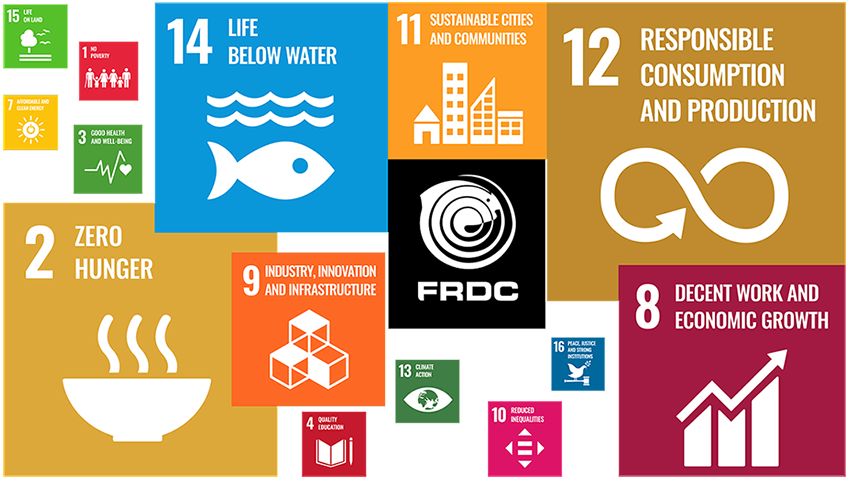
Watch this space!
FRDC is tracking National Agricultural Innovation Priorities, and updates will be shared in FRDC News and Annual Reports.
Fish Forever 2030
The draft Fish Forever 2030 document identifies 18 strategic opportunities aimed at realising a shared vision for fishing and aquaculture: Collaborative, vibrant fishing and aquaculture, creating diverse benefits from aquatic resources, and celebrated by the community. Alignment of FRDC's proposed focus areas for 2021-22 against opportunities identified in Fish Forever 2030 is summarised below.
Alignment of FRDC's proposed focus in 2021-22 against draft Fish Forever 2030 opportunities. Circle size denotes the number of outputs addressing each opportunity. View this in the Annual Operating Plan.
Click on image to view enlarged version
Collaboration
This element directly relates to how well FRDC is able to leverage collaboration across RDCs and among solution providers* to:
- Increase cost effectiveness
- Reduce overlap/redundancy
- Increase overall impact.
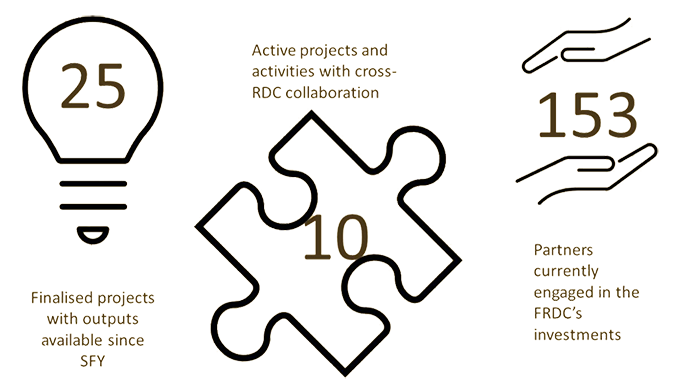
Strategic and sustained cross-sector and cross-industry collaboration
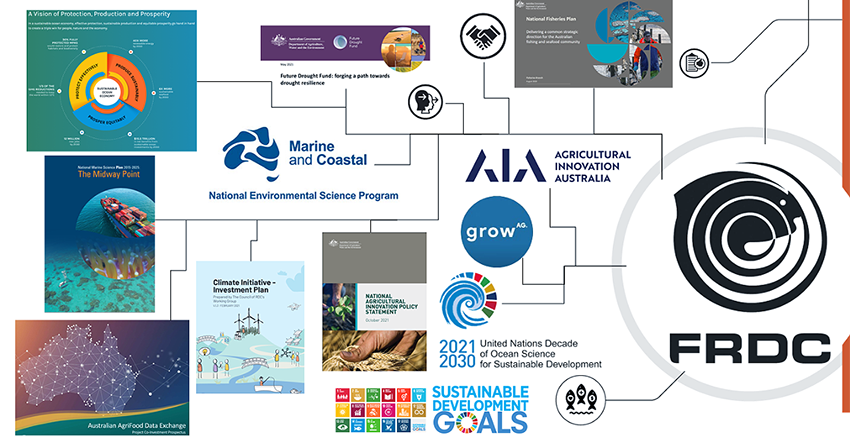
FRDC also seeks to align and partner with national and international initiatives which share aspects of the objectives identified in FRDC's R&D Plan.
"It's good to see people and skills development projects as well, and that led to new collaborations and networks with different researchers that we haven't traditionally worked with, which was great" - Tony Charles (Australian Prawn Farmers Association)
"Within our Industry Partnership Agreement I would say we definitely have some elite collaboration; in one project we have Kailis, the Eastern Rock Lobster Group, Tasmania and the Western Australians, a statistician who sat in on all the meetings, and the Institute for Marine and Antarctic Studies. That was the ultimate collaboration model, and I think everyone loved being part of that team as well because it was so effective." - Tom Cosentino (Southern Rock Lobster Limited)
Resilience and potential
Resilience here refers to the ability of FRDC and the fisheries and aquaculture community to endure over time in a rapidly changing operating landscape. Potential refers to the ability to sustain workforces to meet R&D and business needs. Measurement under this element seeks to ensure no loss and preferably an improvement in the quality or quantity of service delivered by FRDC to the fisheries and aquaculture communities.
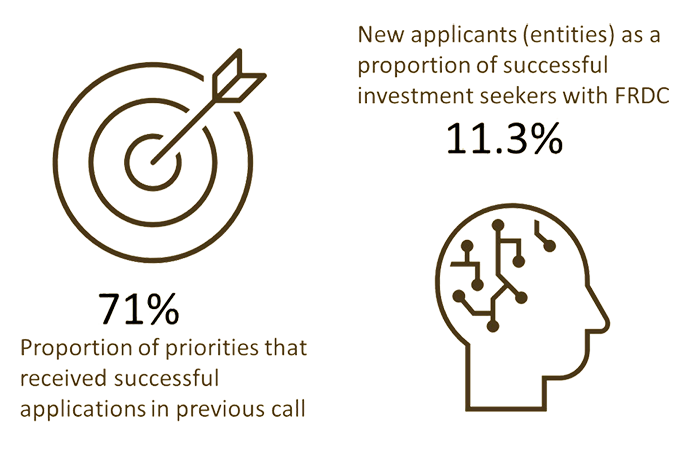
Value
FRDC exists to build partnerships and invest in the generation and sharing of knowledge for the benefit of the Australian community, so that Australia's marine and freshwater resources can be managed and used for fishing and aquaculture sustainably. Value is demonstrated when:
- Stakeholders have been appropriately consulted to determine and prioritise their needs and aspirations
- The services that FRDC provides align with those needs, and are valued by stakeholders
- We are operating efficiently
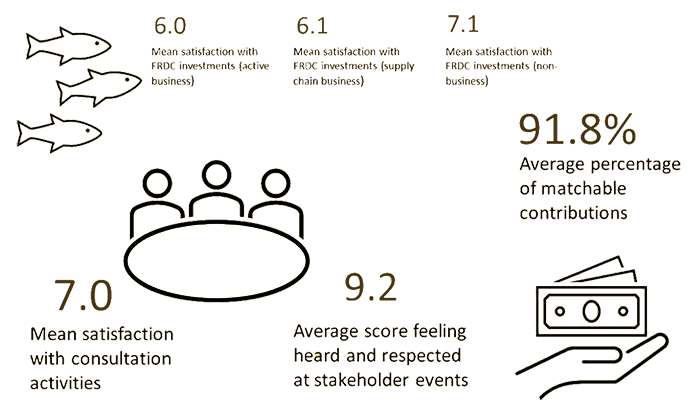
Impact
Impact is a measure of how our activities create benefits for fishing and aquaculture stakeholders, and changes in the operating environment. The most readily measured impact indicators are return on investment, project benefit cost ratio and internal rate of return. These metrics are calculated at the end of each financial year. The most recent reports are listed here.
| Jurisdiction | Return on contribution | Return on contribution 5 Yr |
|---|---|---|
| Commonwealth | 2.58 | 2.91 |
| New South Wales | 5.29 | 7.65 |
| Northern Territory | 4.96 | 5.43 |
| Queensland | 5.99 | 6.69 |
| South Australia | 4.46 | 5.21 |
| Tasmania | 4.42 | 2.88 |
| Victoria | 8.16 | 9.16 |
| Western Australia | 2.38 | 2.49 |
| Total | 3.94 | 3.89 |
| Non State - Jurisdiction | Return on contribution | Return on contribution 5 Yr |
| Australian Farmed Prawns | 0.73 | 2.34 |
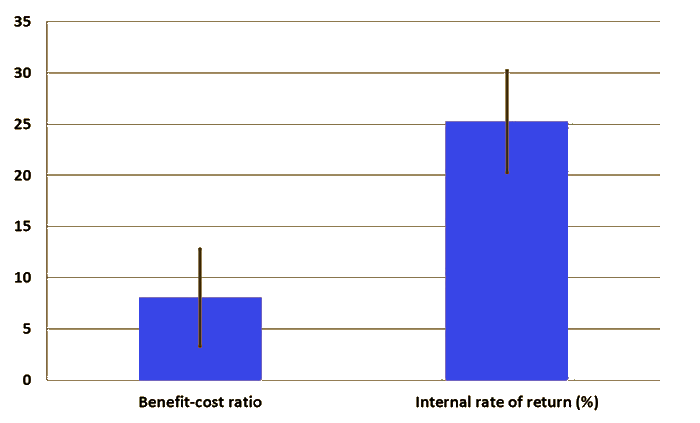
Average benefit cost ratio and internal rate of return (%) of 20 randomly selected samples of projects completed in 2019/20 (with standard error)
Beyond return on investment
We want to start to understand our impacts more. This is challenging as most real impacts can take a long time to see after the R&D is complete, or there are other sources of influence acting on a problem. We are starting to explore ways to monitor both what we are doing to directly influence (lead indicators) change as well as these wider changes themselves (lag indicators).
Market-focussed impacts such as return on investment alone can be misleading. This is because in many instances, investments are targeting non-market impacts such as for public good or environmental improvement. Below are some examples.

We also invest in projects which have more direct market impacts. Here are some examples.
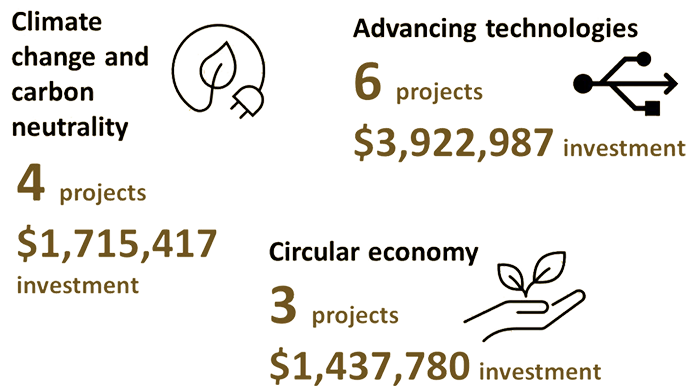
Case study: Stock assessment toolbox developed
FRDC is proud to announce the completion of the Stock Assessment Toolbox for Australian Fisheries (2018-148) which is a major step in advancing Australia towards management of fisheries resources for sustainability.
We are taking a more strategic view of the Australian stock assessment framework. Specifically, to rapidly assess not only data rich but also data poor fisheries' stocks, it is necessary to increase use of off-the-shelf packages. Transitioning to these packages is hampered mainly by their range and lack of consolidation, and by a lack of capability to use them. The Stock Assessment Toolbox for Australian Fisheries centralises links to key freely available packages, allows Australian assessors to contribute their models, and provides resources for their use.
To ensure that this tool stays relevant and is used far into the future, additional work is being done through these projects:
- 2021-002 - Investing in our future: stock assessment and the next generation
- 2021-077 - Development of guidance for conducting stock assessments in Australia
Case study: A framework for advancing social acceptance
Reporting for the second year of this three-year joint RDC initiative has returned important trend data on how perceptions of industry, including Fishing and Aquaculture have been shifting. Importantly, this reporting also explores what drives community trust so we can better understand how to strengthen it.
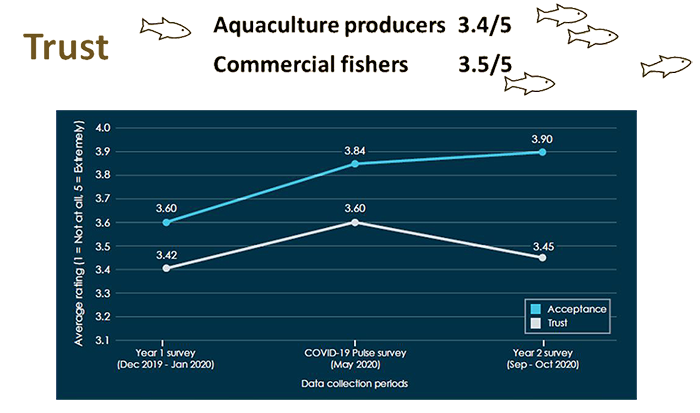
Changes in trust over time
This work is showing that key drivers of trust include environmental responsibility, industry responsiveness, industry products and distributional fairness. For example, while trust in F&A was on a par with trust in rural industries as a whole, there was less trust that F&A acts responsibly. However, the report also shows that when people feel connected to producers, they are more likely to trust them.
For more information and project products, see 2019-042: A framework for advancing social acceptance of the agricultural sector in Australia - A joint RDC initiative.
Case study: Improving safety in WA
It's important to look at available data trends and consider the longer-term impacts of research. Real world impact can take a long time to see, as projects need time to be completed and products adopted by end users.
The FRDC has always been ready to invest in R&D to make the lives of our fishers and aquaculturists safer and longer. Since 1991 in WA alone, there have been 14 projects dedicated to making our work and play safer. From educational materials about severe weather and tropical cyclones to dive safety, a national strategy for OH&S extension, and electronic learning platforms to increase safety, it's a job we take seriously.
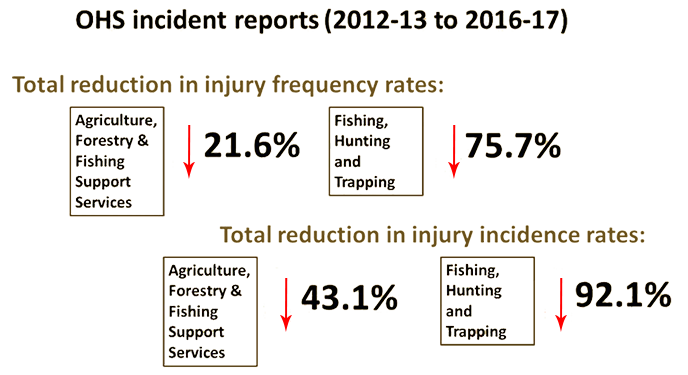
Safety statistics from Worksafe WA industry profile reporting
Performance insights
Our progress against the AOP has been good, and we are on track to achieve our targets by the end of the year. The remaining pieces of work which are quite challenging and in the process of being procured, include gathering baseline information about culture, diversity and values, adoption of harvest strategies and co-management, and the status of fisheries and aquaculture accounting in the Blue Economy.
It is especially noteworthy that the overwhelming majority of FRDC's new funding since the start of the financial year has been dedicated to Horizon 1 R&D, with just under 1% going to more ambitious innovations. This is easy to understand as the immediate priorities focus on visible problems with known solutions. However, with change accelerating globally and across industries, making the move into disruptive and innovative technologies and approaches is increasingly necessary for industry to survive and thrive.
The number of priorities which receive successful applications would ideally be 100%. One way to influence this number is to increase the ratio of new applicants so that we have the right balance of access to capable solution providers. Investment in capability and capacity will be key in ensuring that we can access people with the skills we need.
Average satisfaction scores with our investments among stakeholder groups ranged from 6.0 to 7.0, and we are interested in raising these scores. While stakeholders appear to feel heard and respected, and continue to trust us with their investment, we will continue to explore achievable satisfaction drivers.
We found that there was variation in market impacts such as return on investment and benefit cost ratio. This is appropriate for two reasons. One is that FRDC does not discount projects which show zero financial benefit. Market impacts are only one way in which our research aims to provide positive impacts for our end users, and many projects have a strong focus on public good or environmental impact. Likewise, in a given year, there may be different types of impacts prioritised in different jurisdictions. We also accept a certain level of risk in our investments, which are not always successful. This tallies with our exceptional risk maturity score in relation to other Australian Government entities.




